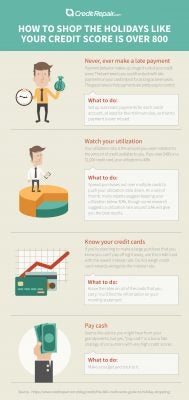
Most of us plan to spend extra money this season on gifts, food, decorations and other holiday-inspired expenses. The average American will spend $830, and 30% of us will drop more than $1,000. Unfortunately, many people will be blindsided later, in 2016, by the consequences of poorly planned holiday spending. If you want to protect your credit score during this time of conspicuous consumption, approach your spending with a credit mindset. Here are a few tips from folks with credit scores over 800.
Never, ever make a late payment
Payment behavior makes up a huge chunk of your credit score. The bad news is that late payments remain on your credit report for seven years. The good news is that payments are pretty easy to control.
Credit score notwithstanding, creditors give us plenty of other reasons to pay on time, not least of which are massive fees and interest charges. Your account could convert to a very high penalty interest rate (typically around 30%) after just one late payment.
Another gotcha: some zero-percent offers are actually deferred-interest offers. That means if you pay as agreed for the specified time period, no interest is charged. But make a single late payment and the creditor has the right to charge interest on the entire original balance, all the way back to the transaction date.
The last kicker: some creditors will slap a penalty rate on all of your accounts if they find out that you’ve made a late payment on any account!
What to do:
- Set up automatic payments from an asset account to each credit account, at least for the minimum due, so that no payment can be missed.
Watch your utilization
Your utilization ratio is the amount you owe in relation to the amount of credit available to you. If you owe $400 on a $1,000 credit card, your utilization is 40%. The ratio is calculated for each card, and overall. Experts do not agree on the best utilization ratio, but everyone agrees that the lower it is, the better. FICO reports that consumers with credit scores over 800 typically maintain a utilization ratio of no more than 7%.
Utilization is usually reported on the statement closing date, not the payment due date. So even if you pay your balances in full each month, your utilization could appear artificially high because it’s reported before the creditor receives your payment.
What to do:
- Spread purchases out over multiple cards to keep the utilization ratio from going too high on any one account.
- Call your creditor to find out what day the balance is reported, and make your payment before that date to ensure the lowest possible balance is reflected in your credit score.
Know your credit cards
We’d all like to pay off our balances every month, but that isn’t always possible. If you’re planning to make a large purchase that you know you can’t pay off right away, use the credit card in your wallet with the lowest interest rate. Do not weigh credit card rewards alongside the interest rate. You’ll lose money every time. Rewards strategies only work for consumers who don’t carry a balance.
What to do:
- Know the rates on all of the cards that you carry. You’ll find the information on your monthly statement.
Pay cash
Seems like advice you might hear from your grandparents, but yes, “pay cash” is a bona fide strategy of consumers with very high credit scores. If they can’t afford a purchase, they don’t just put it on a credit card. They do without. If you don’t trust yourself to resist temptation while shopping, carry cash or a debit card and leave the credit card at home.
What to do:
- Make a budget and stick to it.
Questions about credit repair?
Chat with an expert: 1-800-255-0263







